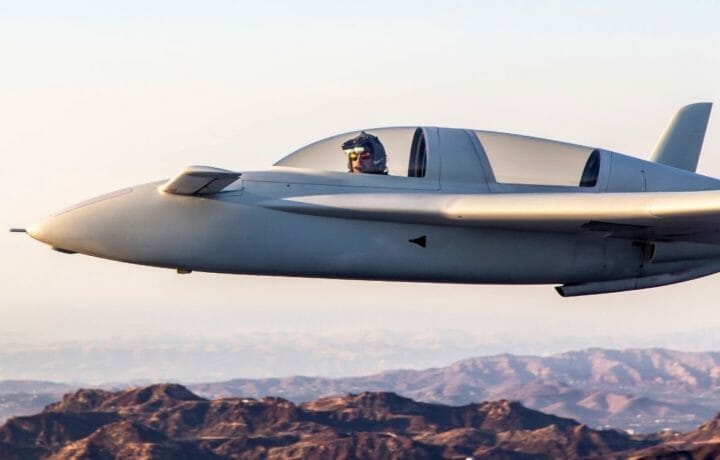Flight simulators aren’t exactly new, and since the original Link Trainer was developed in 1929 by Edwin Albert Link of Binghamton, NY, such tools have been used to help train pilots. Link’s original designs incorporated pumps, valves, and bellows to mimic what a pilot might experience – and his trainers proved crucial for training American pilots during the Second World War. In the more than 90 years since that first trainer, aircraft simulators have gotten far more advanced and in recent years, the United States Air Force has even adopted virtual reality (VR) technologies to help get trainee pilots up to speed.
While VR has its benefits, one area where it still falls short is in training fighter pilots. One reason is that while the technology can create a realistic environment for level flying and teach trainees to use the controls, it still lacks key aspects that simply can’t be simulated.
Red 6’s Airborne Tactical Augmented Reality System (ATARS)
This is where Red 6’s Airborne Tactical Augmented Reality System (ATARS) can bridge the gap from the fully virtual to the physical reality of the world. Its system was developed as part of the United States Air Force’s tech incubator, AFWERX, which awarded the Santa Monica, California-based company a $1.5 million development grant to create a combat training system that utilized augmented reality (AR) rather than pure VR.
Recently, the company announced that it had raised $7 million in the form of a SAFE (Simple Agreement for Future Equity). The round was led by Red Cell, Snowpoint Ventures, and Octave. That investment will allow Red 6 to mature the development of both Airborne Tactical Augmented Reality System (ATARS) and Combined Augmented Reality Battlespace Operational Network (CARBON).
The Augmented Reality Experience is Better than Just Virtual
The result is ATARS, the first wide field-of-view, full color demonstrably proven outdoor augmented reality solution that works in dynamic outdoor environments. ATARS allows Virtual and Constructive assets into the real-world by allowing pilots and ground operators to see synthetic threats in real-time, outdoors and, critically, in high-speed environments.
It can help trainee pilots prepare for close range air-to-air combat, ground attacks and refueling missions – all of which can be complex, expensive and dangerous in the real world. It is a combination of AR and artificial intelligence (AI) that can simulate combat in a real world environment.
“Simulations remain very important to the pilot training,” said Daniel Robinson, founder and CEO of Red 6. “It can even go much of the way to provide the pilot with the experience they need in the real world, but what it can’t go all of the way.”
Robinson told ClearanceJobs that what is missing is the physical experience.
“Piloting a combat aircraft is extremely taxing,” he explained. “You have the risk that includes crashing into the ground, running out of fuel and even just the physical exhaustion that comes when you hit multiple Gs while flying. This all increases the cognitive load on the pilots and it detracts from the ability to perform at an optimum load.”
Such training can be done with real aircraft, where another pilot attempts to “simulate” being an adversary but that can be dangerous as well as costly.
“Flying an F-22 Raptor at $70,000 an hour to simulate an enemy plane is really expensive,” added Robinson. “We are sitting at this intersection between real flying and simulation. With ATARS the pilot is in a real cockpit, but is training against a simulation.”
ATARS Makes Peer Adversaries Realistic
With ATARS all the “enemy aircraft” exist only as software, which the trainee pilot can see via a modified flight helmet. Through this technology those enemies can be such advanced aircraft as the fifth-generation Chinese J-20 or Russian Sukhoi Su-57 fighter jets, aircraft that are only now entering service in their respective nations.
And because those aircraft are virtual, they can be “updated” accordingly, so as new functionality or capabilities are learned the program can accommodate. That can prepare pilots far better than having them fly against F-15s or other U.S. aircraft.
Additionally, it allows all Air Force pilots to remain the good guys and reduces the need for someone to play the aggressor role.
“We don’t need someone to go up and play ‘bad guys’ in the sky,” said Robinson. “All our pilots should be training to be the good guys, or the blue team aircraft. This can create a new paradigm in training.”
As noted, the technology is infinitely upgradable, while also being software driven. Thus it can be continually updated as needed. At the same time all of the normal training procedures – as well as accompanying risks – remain in place. It can also be used by multiple pilots at the same time, with everyone on the same team.
“Pilots will look out and see the adversary aircraft and can respond according in this synthetic training environment,” added Robinson. “Think of it as a large multiplayer game played out in a very real sky. It creates a new training environment.”




